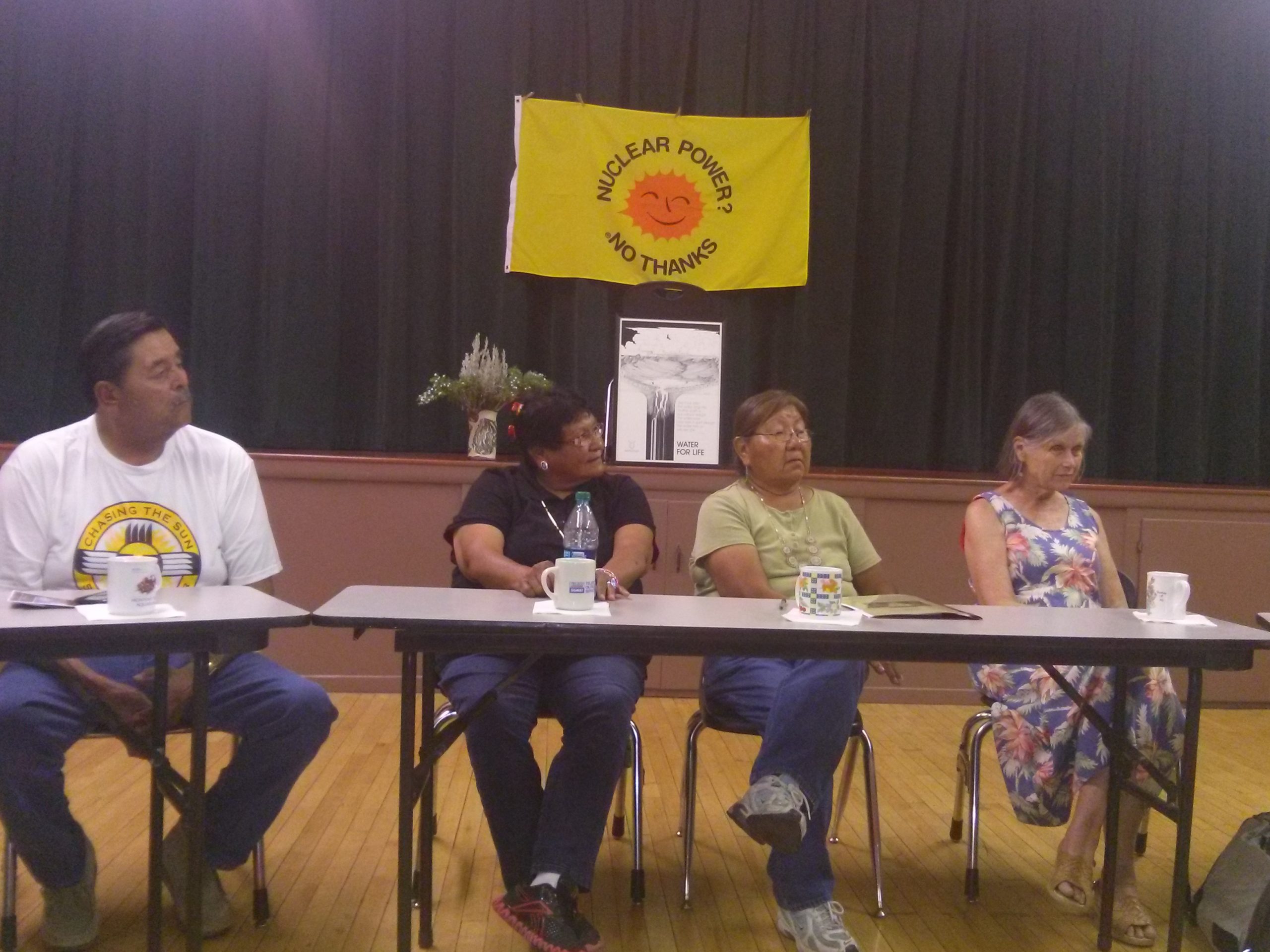Some information may be outdated.
Tribal representatives from the Colorado River Indian Tribes (CRIT), as well as from the Ute and Goshute tribes, expressed their concerns about a proposed nuclear power plant near Green River at a public meeting that took place at the Moab Arts and Recreation Center (MARC) on Monday, August 18.
Close to 50 local residents turned out to hear what they had to say.
The representatives traveled from as far away as Parker, Ariz., to gather information, tour the site of the proposed nuclear facility, and to express their concerns about river contamination and water over-consumption on the Green River, the largest tributary of the Colorado River.
“I have concerns about this,” CRIT council representative Johnny Hill said. “Our water is very precious. It’s more precious than gold. This is our agriculture, our income, our beef, our chicken, our food.”
CRIT is a geo-political organization made up of four separate Indian tribes who live on the Colorado River Indian Reservation that straddles the lower Colorado River in Arizona and California. Agriculture makes up a large portion of their economy, and it is dependent on irrigation water from the Colorado River.
“Taking care of this river is very important to us,” CRIT council representative Amanda Barrera said. “We hold seniority rights to it. We are here to educate ourselves and take information back to our people.”
Forrest Cuch, a Ute Indian from the Uintah Basin, said he came down, “to join my native brothers and sisters to oppose the nuclear power plant.”
Cuch said that he has already seen too much destruction from the oil and gas industry in the Uintah Basin, and that the risk for catastrophe with a nuclear power plant is too high.
“They had the ocean in Fukishima,” he said. “Imagine polluting the Colorado River.”
Margene Bullcreek, a Skull Valley Goshute who led the fight with the State of Utah to prevent spent nuclear rods from being stored on the Goshute reservation, voiced her opposition. She also asked how the State of Utah could support the construction of a nuclear power plant when they fought so hard to keep nuclear waste from being stored here.
“We need to protect our environment,” she said. “We have one air, one water.”
There are currently no long-term storage facilities for nuclear waste in the U.S., and spent, radioactive fuel roads are stored on-site at existing nuclear power plants.
Utah-based Blue Castle Holdings (BCH), led by former state representative Aaron Tilton, is planning to build two 1,500-megawatt reactors on a 1,700-acre parcel of land near Green River. The project would require water from the Green River to cool its reactors.
In 2012, Utah State Engineer Kent Jones, gave approval for 53,000 acre-feet of water rights held by Kane and San Juan counties to be leased to BCH. The decision raised concerns about the project, including local water-use interference, effects on endangered fish and wildlife, over-allocation of Colorado River water and radiological contamination, as well as safety and operational concerns, Uranium Watch program director Sarah Fields said.
The nonprofit organization HEAL Utah, with co-plaintiffs Uranium Watch, Utah Rivers Council, and Living Rivers, contested the decision in court. In December 2013, Seventh District Judge George Harmon ruled the project won’t jeopardize the availability of water supplies, and he approved a water-rights transfer for the reactor’s cooling towers.
The plaintiffs have filed an appeal.
John Weisheit of Living Rivers said that the Colorado River is already known to be over-allocated and that reservoirs are shrinking. Weisheit said that the state engineer and Judge Harmon have allocated more water, a move that he said will create more conflict for unfulfilled water rights from the Colorado River system and also lessen in-stream flows for the recovery of endangered fish.
“They are putting tribal water rights at risk,” he said.
Proponents of the project say that it will be an economic boon to Emery County, and that water use by the plant will be negligible.
“I am 100-percent in favor of a nuclear power plant in Green River,” Emery County commissioner J.R. Nelson said. “I’m convinced these (tribal) elders want to preserve their lifestyle without accepting change.”
Nelson said that the 75 cubic feet per second (cfs) of water required to run the plant is insignificant and he compared it to the lowest water years recorded on the Green River that measured around 600 cubic cfs.
“I’m just a hobby farmer and I run that much (75 cfs) through my field,” he said.
Emery County economic director Mike McCandless said that according to projections from BCH, the project could provide up to 2,500 jobs during the construction phase and up to 1,000 full-time jobs once the plant is operational. He also said Grand County would likely benefit as workers choose to live in Moab.
“We view this as a regional economy,” he said.
Blue Castle Holding still has other hurdles to cross. The Nuclear Regulatory commission hasn’t issued a permit for a new nuclear power plant since 1977. In addition, permitting the project could cost up to $200 million, and construction could cost as much as $18 billion. The company has already spent $17.5 million in initial studies.
“This is so ‘pie in the sky,’ it’s frustrating,” Fields said. “When you go to Green River and you see people putting all their marbles in this basket instead of focusing on more viable economic development projects, it’s like buying a lottery ticket.”
Pros, cons of Green River plant heard at Aug. 18 meeting
“Taking care of this river is very important to us. We hold seniority rights to it. We are here to educate ourselves and take information back to our people.”
Appreciate the coverage? Help keep local news alive.
Chip in to support the Moab Sun News.





